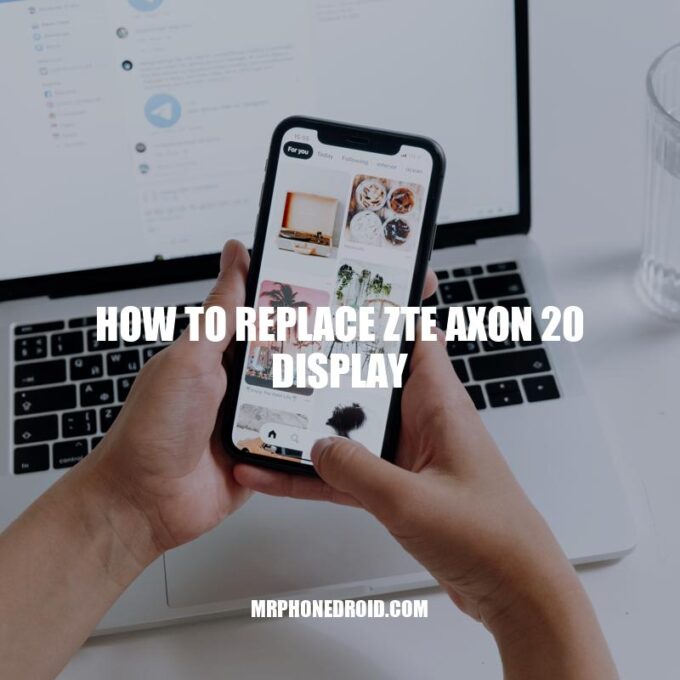Whether you’re a parent trying to keep track of your child’s online activities or an employer looking to monitor your employees’ internet usage, using a keylogger software can be helpful. A keylogger is a type of monitoring tool that records every keystroke made by the user on their computer or mobile device, making it possible to see everything that was typed, including passwords, emails, and messages. It can also capture screenshots and track the websites they visit. Although some people consider keylogging as an invasion of privacy, there are legitimate reasons why you may want to use one. In this article, we’ll discuss the keylogger software, how it works, its benefits and drawbacks, and the top keylogger programs that you can use.
How To Replace ZTE Axon 20 Display
If you have a cracked or broken ZTE Axon 20 display, replacing it is relatively easy to do yourself with the right tools and knowledge. Here are the steps you need to follow:
- Power off your ZTE Axon 20. This is an important step to keep you safe during the repair process.
- Remove the back cover. Use a heat gun or hairdryer to warm the edges of the back cover adhesive, then use a pry tool or suction cup to lift the cover off.
- Unscrew and remove the metal plate. This will give you access to the display connector and motherboard.
- Disconnect the display connector cable. Use a pry tool to lift the connector, then gently pull the cable out.
- Remove the broken display. Gently pry the display away from the adhesive holding it to the frame.
- Prepare the replacement display. Remove any protective films and apply adhesive tape to the back of the new display.
- Attach the replacement display. Carefully align the display with the frame and press it into place.
- Reconnect the display connector. Gently insert the cable into the connector and press down to secure it.
- Screw in the metal plate. Make sure it is securely in place before moving on.
- Attach the back cover. Apply new adhesive to the edges of the cover and carefully press it into place.
- Power on your ZTE Axon 20. If everything is working properly, you should now see the new display.
Where to Buy ZTE Axon 20 Replacement Displays?
You can find ZTE Axon 20 replacement displays online at a variety of retailers and vendors. Make sure to purchase a high-quality replacement display that is compatible with your device model. You can find compatible replacement displays at the ZTE official website or other trusted online retailers such as Amazon or eBay.
Conclusion
Replacing a broken ZTE Axon 20 display may seem daunting, but with the right tools and knowledge, it can be done easily at home. Be sure to take your time, follow the steps carefully, and double-check your work before powering on your device again. If you’re not comfortable with the repair process, consider taking your device to a professional repair shop.
How does keylogger software work?
A keylogger software is a type of malware that secretly tracks and records your keystrokes as you type. It can be installed on a computer without the user’s knowledge. The captured information is then sent to a hacker using a command-and-control server. This type of software can be used to steal sensitive information such as passwords, credit card numbers, and personal information. It is important to use antivirus software and keep it updated to protect against keyloggers.
If you need to replace the display on your ZTE Axon 20, don’t worry! It’s possible to do it yourself with the right tools and guidance. Here’s a step-by-step guide to help you through the process:
Step 1: Turn off your ZTE Axon 20 and remove the SIM card tray.
Step 2: Use a heat gun or a hair dryer to gently heat the edges of the back panel. This will soften the adhesive and make it easier to remove the panel.
Step 3: Once the adhesive is soft, use a plastic prying tool to gently pry the back panel away from the phone. Be careful not to damage the panel or any cables that may be attached.
Step 4: Use a screwdriver to remove the screws that are holding the battery and the motherboard in place. Carefully disconnect any cables or connectors that are attached to the motherboard.
Step 5: Remove the motherboard to access the display.
Step 6: Use a heat gun or a hair dryer to gently heat the display. This will soften the adhesive holding it in place.
Step 7: Use a plastic prying tool to gently pry the display away from the phone. Be careful not to damage the display or any cables that may be attached.
Step 8: Install the new display by following these steps in reverse order.
Step 9: Replace the back panel and the screws that hold it in place.
Step 10: Finally, turn on your ZTE Axon 20 to see if the new display is working properly.
Important: Make sure to use caution when handling the fragile internal components of your ZTE Axon 20. If you are not confident with your skills, it’s best to seek professional help or guidance.
If you need to purchase a new display for your ZTE Axon 20, look for a reputable supplier that offers high-quality replacement parts. You can find a variety of ZTE Axon 20 displays online or at local electronics stores.
With a little patience and careful attention to detail, you can successfully replace the display on your ZTE Axon 20 and enjoy a fully functioning phone once again.
What are the types of keyloggers?
There are three main types of keyloggers: form-grabbing keyloggers, JavaScript keyloggers, and API keyloggers. Form-grabbing keyloggers record data that is entered into a specific field, while JavaScript keyloggers are embedded into websites using JavaScript code. API keyloggers are installed inside of applications, allowing them to record every keystroke made within the app.
If you are looking for information on how to replace ZTE Axon 20 display, then you have come to the right place. Here are some steps to guide you through the process:
1. Get the necessary tools: To replace the ZTE Axon 20 display, you will need a set of professional tools, including a screwdriver set, a prying tool, a suction cup, and a heat gun.
2. Power Off the Phone: Before starting the process of replacing ZTE Axon 20 display, make sure your phone is switched off and the battery is disconnected.
3. Remove Back Cover: Use the prying tool to carefully remove the back cover of your ZTE Axon 20.
4. Heat the Screen: Using a heat gun, gently heat the edges of the screen display to make it easier to remove.
5. Remove Screen Display: Use a suction cup and prying tool to gently lift the screen display away from the body of the phone.
6. Replace with New Screen: Once the damaged screen is removed, carefully install brand new replacement screen display for ZTE Axon 20 in the same position as the old one.
7. Reattach Back Cover: After the new display screen is properly installed, reattach the back cover of your ZTE Axon 20 using the screws and other accessory parts.
Remember: If you are not confident in replacing the ZTE Axon 20 display screen by yourself, you can take it to a professional technician who has the necessary expertise to complete the task successfully.
In conclusion, replacing the ZTE Axon 20 display screen requires careful attention to detail and professional tools. With proper guidance and adequate time and attention, anyone can replace their ZTE Axon 20 display screen with a brand new one, thus restoring their phone to optimal condition.
How do you prevent keyloggers?
There are several ways to prevent keyloggers, including keeping your antivirus software up to date, being cautious of suspicious email attachments, avoiding clicking on links from unknown sources, and using a virtual keyboard instead of a physical keyboard when entering sensitive information. Additionally, using password managers like LastPass or 1Password can help prevent keyloggers, as they can autofill login details without the need for typing.
Conclusion
In summary, keyloggers can pose a significant threat to your privacy and security by collecting sensitive information such as passwords, credit card numbers, and personal details. Using a reliable anti-malware program, being cautious when downloading software, avoiding public Wi-Fi networks, and using two-factor authentication are some of the measures that you can take to protect yourself against keylogger software.
If you believe that your device has been infected with keylogger software, you should take immediate action by changing your passwords, scanning your device with anti-malware software, and monitoring your accounts closely for any suspicious activity.
While it may seem daunting to protect yourself from keyloggers, following these tips can go a long way in securing your sensitive information and minimizing the risks of identity theft and fraud. By taking proactive measures to safeguard your privacy, you can enjoy a worry-free online experience and stay one step ahead of cybercriminals.
Remember, prevention is always better than cure. By being proactive and staying vigilant, you can avoid falling victim to keylogger attacks and keep your personal information safe and secure.




